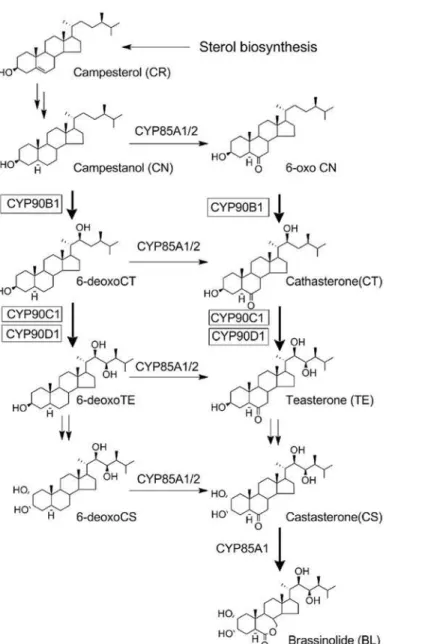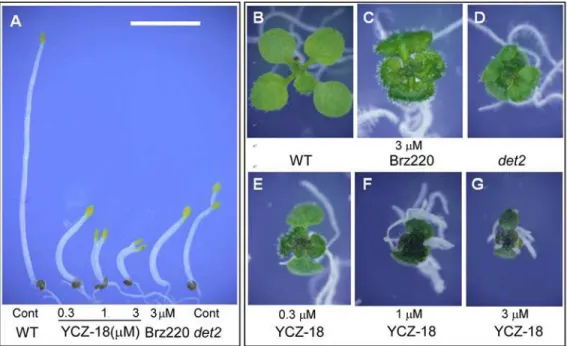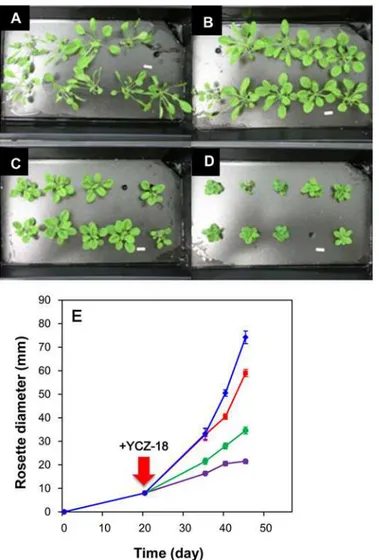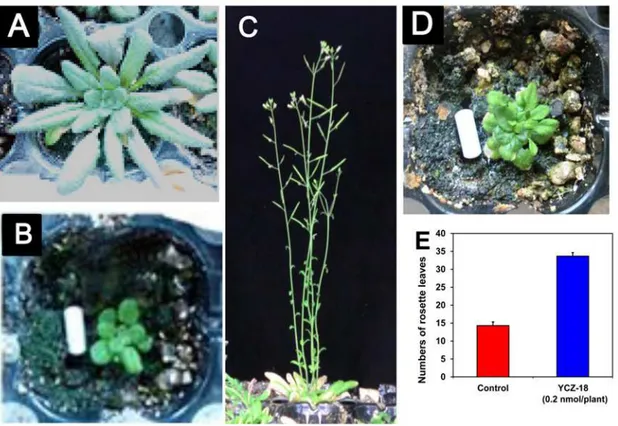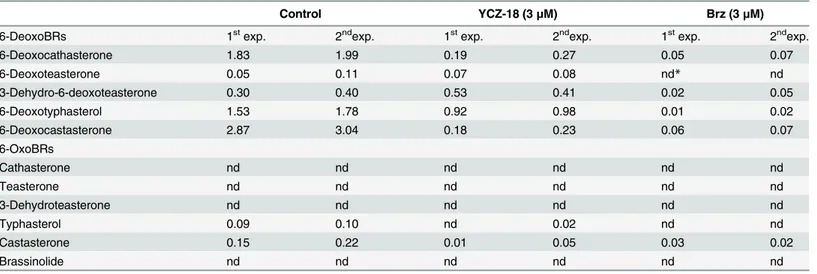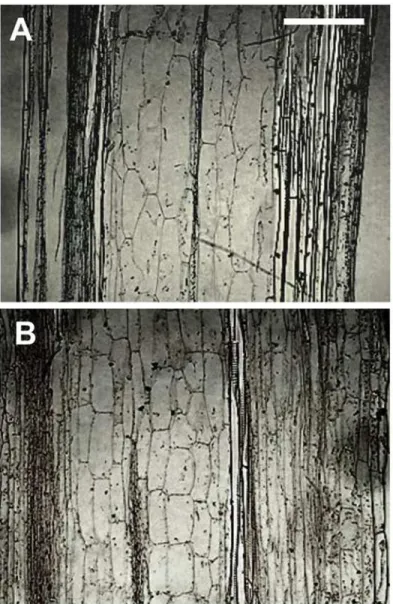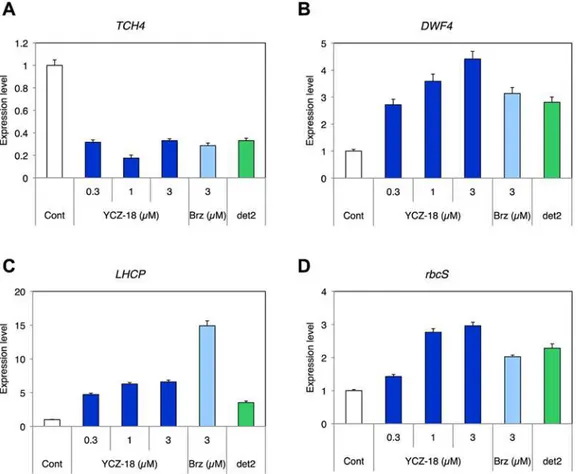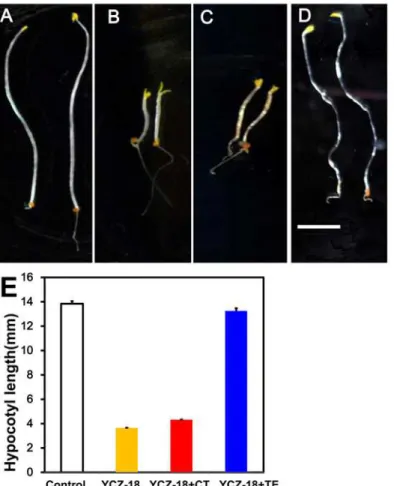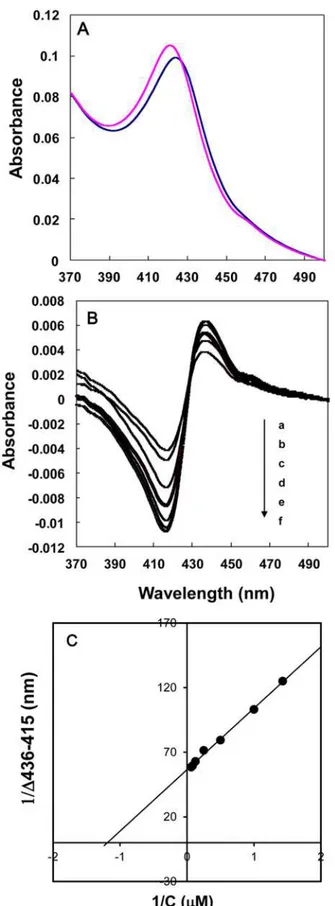YCZ-18 Is a New Brassinosteroid Biosynthesis
Inhibitor
Keimei Oh1*, Tadashi Matsumoto1, Ayumi Yamagami2, Atushi Ogawa3, Kazuhiro Yamada1, Ryuichiro Suzuki3, Takayuki Sawada4, Shozo Fujioka2,5, Yuko Yoshizawa1, Takeshi Nakano2,5,6
1Department of Biotechnology, Faculty of Bioresource Sciences, Akita Prefectural University, Shimoshinjo Nakano, Akita, Japan,2Antibiotics laboratory, RIKEN, 2–1 Hirosawa, Wako, Saitama, Japan,3Department of Bioproduction, Faculty of Bioresource Sciences, Akita Prefectural University, Shimoshinjo Nakano, Akita, Japan,4Biotechnology Research Center, Faculty of Bioresource Sciences, Akita Prefectural University, Shimoshinjo Nakano, Akita, Japan,5RIKEN Center for Sustainable Resource Science, Wako, Saitama, Japan,6CREST, Japan Science and Technology Agency, Kawaguchi, Saitama, Japan
*jmwang@akita-pu.ac.jp
Abstract
Plant hormone brassinosteroids (BRs) are a group of polyhydroxylated steroids that play critical roles in regulating broad aspects of plant growth and development. The structural di-versity of BRs is generated by the action of several groups of P450s. Brassinazole is a spe-cific inhibitor of C-22 hydroxylase (CYP90B1) in BR biosynthesis, and the application use of brassinazole has emerged as an effective way of complementing BR-deficient mutants to elucidate the functions of BRs. In this article, we report a new triazole-type BR biosynthesis inhibitor,YCZ-18. Quantitative analysis the endogenous levels of BRs inArabidopsis indi-cated thatYCZ-18significantly decreased the BR contents in plant tissues. Assessment of the binding affinity ofYCZ-18to purified recombinant CYP90D1 indicated thatYCZ-18 in-duced a typical type II binding spectrum with a Kdvalue of approximately 0.79μM. Analysis
of the mechanisms underlying the dwarf phenotype associated withYCZ-18treatment of Arabidopsisindicated that the chemically induced dwarf phenotype was caused by a failure of cell elongation. Moreover, dissecting the effect ofYCZ-18on the induction or down regu-lation of genes responsive to BRs indicated thatYCZ-18regulated the expression of genes responsible for BRs deficiency inArabidopsis. These findings indicate thatYCZ-18is a po-tent BR biosynthesis inhibitor and has a new target site, C23-hydroxylation in BR biosynthe-sis. Application ofYCZ-18will be a good starting point for further elucidation of the detailed mechanism of BR biosynthesis and its regulation.
Introduction
The oxidative metabolism of campesterol in plant tissues leads to the production of a group of bioactive polyhydroxylated steroids, collectively called brassinosteroids (BRs). BRs are impor-tant plant hormones that play critical roles in regulating broad aspects of plant growth and de-velopment [1]. BRs act as essential regulators in cell elongation, cell division, and sex
OPEN ACCESS
Citation:Oh K, Matsumoto T, Yamagami A, Ogawa A, Yamada K, Suzuki R, et al. (2015) YCZ-18 Is a New Brassinosteroid Biosynthesis Inhibitor. PLoS ONE 10(3): e0120812. doi:10.1371/journal. pone.0120812
Academic Editor:Miguel A Blazquez, Instituto de Biología Molecular y Celular de Plantas, SPAIN
Received:July 5, 2014
Accepted:February 5, 2015
Published:March 20, 2015
Copyright:© 2015 Oh et al. This is an open access article distributed under the terms of theCreative Commons Attribution License, which permits unrestricted use, distribution, and reproduction in any medium, provided the original author and source are credited.
Data Availability Statement:All relevant data are within the paper.
Funding:This study was supported in part by funding from the Akita Prefectural University President’s Research Project to KO and the CREST, Japan Science and Technology Agency to TN. The funders had no role in study design, data collection and analysis, decision to publish, or preparation of the manuscript.
determination [2–3]. Mutants with impaired BR synthesis display dramatic growth defects, such as decreased cell elongation, resulting in pleiotropic dwarf phenotypes, delayed flowering, and male sterility [4–7]. BRs also modulate plant metabolic pathways in response to environ-mental biotic and abiotic stress resistance, including tolerance of salt, drought and oxidative stresses and pathogen resistance [8,9].
Because BRs are involved in controlling plant architecture, seed yields and stress resistance, manipulating BR levels in plant tissues is considered useful for enhancing crop production. The use of transgenic techniques to manipulate endogenous BR levels has a remarkable effect on plant growth. Overexpression of DWARF4, an enzyme that catalyzes a rate-limiting step in BR biosynthesis, enhances plant growth and seed yield inArabidopsis thaliana(hereafter Ara-bidopsis) [10]. Similarly, transgenic rice plants overexpressing a sterol C-22 hydroxylase that catalyzes a key step in BR biosynthesis show increased biomass and seed yields [11], and avail-able evidence indicates that mutations in BR biosynthesis may be a means to improve biomass production [12]. Consequently, the biosynthetic pathway of BRs is a potential target for engi-neering in terms of crop protection [13].
An alternative method for manipulating the BR levels in plant tissues is the use of specific inhibitors targeting the enzymes involved in BR biosynthesis. Because agrochemicals have been widely used for crop protection in the modern agricultural industry, this method has advan-tages over the use of BR-deficient mutants, as it can be used at different sadvan-tages of plant growth and development [14]. Moreover, inhibitors can easily be applied to different plant species. In this context, the search for potent inhibitors of BR biosynthesis represents a worthwhile ap-proach to develop new technologies for manipulating BR levels in plant tissues.
The biosynthetic pathways of BRs were initially elucidated by tracer experiments using vari-ous labeled precursors of brassinolide (BL) in periwinkle (Catharanthus roseus) cell lines [15]. The pathways were later validated by analyzing the endogenous levels of BRs in BR-deficient mutants [4,16]. With the combination of genetic and biochemical approaches, the entire meta-bolic pathway in the biosynthesis of BRs has been identified (Fig. 1) [17]. Molecular and func-tional analysis of the BR biosynthesis mutants demonstrated that BR biosynthesis was mediated by several cytochrome P450 monooxygenases (P450s). DWF4/CYP90B1 is thought to catalyze the C-22 hydroxylation of campesterol (CR) [16]. CPD/CYP90A1 is thought to be involved in the C-3 dehydrogenation of steroid skeletons [18]. CYP90C1/ROT3 and
CYP90D1, which are genetically closely related, are shown to have redundant functions as C-23 hydroxylases [19].ArabidopsisCYP85A1 and CYP85A2 were found to catalyze the C-6 oxi-dation reaction [20]. These observations indicate that many steps in BR biosynthesis are cata-lyzed by P450 enzymes (Fig. 1). Therefore, it is reasonable to postulate that the biosynthetic pathway of BRs is an expedient target for P450 inhibitors. Likewise, the multiplicity of P450s in BR biosynthesis suggests the possibility of developing P450 inhibitors targeting different steps of BR biosynthesis, thereby allowing us to probe the detailed mechanism of BR biosynthesis and its regulation.
The mechanisms of inhibition of P450 have been studied in considerable detail [21]. Tria-zole derivatives have been demonstrated to have widespread ability as P450 inhibitors due to the intrinsic affinity of the nitrogen electron pair in heterocyclic molecules for the prosthetic heme iron. The triazole derivatives thus bind not only to lipophilic regions of the protein but also simultaneously to the prosthetic heme iron [22]. Accordingly, the chemical structures be-yond the triazole moiety in P450 inhibitors of the triazole type are of significant importance re-garding the selectivity of P450 inhibition.
Fig 1. Outline of the BR biosynthetic pathway and P450.
doi:10.1371/journal.pone.0120812.g001
Fig 2. Chemical structures of brassinosteroid biosynthesis inhibitors.
To explore new inhibitors with novel target sites in BR biosynthesis, we have been developing P450 inhibitors targeting BR biosynthesis [27–30]. Using an approach based on ketoconazole as a molecular scaffold, we found a new series of inhibitors of BR biosynthesis(YCZ-series)
[27]. Structure-activity relationship studies ofYCZsrevealed a highly selective and potent in-hibitor:YCZ-18(chemical structure shown inFig. 2) [28,29]. Stereochemical structure-activity relationship studies led to the identification of2R,4S-YCZ-2013and2S,4R-YCZ-2013,
ana-logues ofYCZ-18, which are the most potent BR biosynthesis inhibitors found to date, with IC50values of approximately 24 ± 2 and 24 ± 1 nM, respectively [30].
In the present work, we report a biochemical and physiological characterization ofYCZ-18. Our results indicate thatYCZ-18is a specific BR biosynthesis inhibitor with a wide range of ap-plicability for altering BR biosynthesis inArabidopsis. Assessment of the target site ofYCZ-18
indicates that one of its targets is CYP90D1, which differentiatesYCZ-18from brassinazole, a known BR biosynthesis inhibitor.
Materials and Methods
Chemicals
Synthesis and purification ofYCZ-18were carried out according to a method described previ-ously [27]. Teasterone (TE) and brassinolide (BL) were purchased from Brassino Co., Ltd. (To-yama, Japan). Cathasterone (CT) was provided by Professor Suguru Takatsuto of Joetsu University of Education. Brz 220 was a gift provided by Professor Tadao Asami of The Univer-sity of Tokyo. Other reagents of the highest purity were purchased from Tokyo Chemical In-dustry Co., LTD. (Tokyo, Japan) or Wako Pure Chemical Industries, Ltd. (Tokyo, Japan). All the chemicals for biological studies, unless otherwise described, were dissolved in DMSO and stored at -30°C before use.
Plant materials and growth conditions
Arabidopsis thalianaColumbia-0 (Col-0) was used in all the experiments. BR-deficient mutant
de-etiolation2(det2) [31] and Brz220, a potent BR biosynthesis inhibitor [23], were used as positive controls. Untreated plants were used as controls for comparison with the chemical-in-duced phenotype. Plants were germinated and grown on half-strength Murashige and Skoog (MS) medium containing 1.0% sucrose and 0.9% phyto-agar (Duchefa), in the presence or ab-sence of inhibitors and/or BRs. Seed sterilization and seed handling were carried out as de-scribed previously [29]. Conditions in the growth chamber were 16 h light (100μE m-2sec-1
white light)/8 h dark at 22°C unless otherwise indicated. For gene expression analysis, ground tissue from whole seven-day-old seedlings was used.
YCZ-18 treatment under soil and hydroponic culture conditions
Soil: Seeds were sown in soil and grown in controlled environments (16/8 h light/dark cycle, 22°C, 50–60% relative humidity). Ten-day-oldArabidopsisplants were sprayed with an aque-ous solution ofYCZ-18(5μM containing 0.1% DMSO, approximately 0.1 pmol/plant). Two
days later,YCZ-18was sprayed on plants in the same way for the second time, and the plants were allowed to continue to grow in soil for observations of chemical-induced phenotypes. Plants sprayed with an aqueous solution of DMSO were used as a control.
grown in culture medium [32] with the indicated concentrations ofYCZ-18(0.1, 0.5, 1μM).
Plants grown in culture medium withoutYCZ-18were used as controls.
Quantitative analysis of brassinosteroids
To determine the endogenous levels of BRs, seedlings ofArabidopsis(wild type (control), YCZ-18-treated (3μM), Brz-treated (3μM)) were harvested to yield approximately 15 g fresh weight
tissues. The tissues were extracted twice with 250 ml of methanol. Deuterium-labeled internal standards (1.5 ng/g fresh weight) were added to the extracts. Purification and quantification of brassinosteroids were performed according to the methods described previously [33,34].
Microscopic analysis
Plants treated without or withYCZ-18(1μM) were grown under hydroponic conditions in a
growth chamber under standard conditions, as described above. The inflorescence stems from seven-week-old plants were dissected. The tissue was fixed in FAA for 16 h at 4°C, dehydrated with a graded ethanol series, embedded in paraffin, sectioned longitudinally in 10-μm slices
using a microtome (Microm HM360, Microm, Laborgerät GmbH, Walldorf, Germany) and dried at 37°C. Paraffin was removed from the sections with xylene. The prepared slides were hydrated in an ethanol-water series and stained with hematoxylin. They were then dehydrated in a graded water-ethanol series, ethanol-xylene and then xylene. The slides were mounted with Eukitt and image data was captured under a microscope (BX51, Olympus, Japan). The cell length of pith in stem was calculated from the image data using Image J (Version 1.48, Na-tional Institute of Health, USA). The length of ten cells with three replications was measured in each treatments and the mean and standard deviation were calculated.
Quantitative real-time PCR
The methods for total RNA isolation, cDNA synthesis, and real-time PCR have been previously described [35]. The sequences of the gene-specific primers for real-time PCR were as follows: for
TCH4, 5’- CGAGTCTTTGGAACGCTGAT-3’and 5’-CTTCTTGTTGAAAGCCACGG-3’; for
DWF4, 5’-CATAAAGCTCTCTTCAGTCACGA-3’and 5’ -CGTCTGTTCTTTGTTTCCTAA-3’; forLHCP, 5’-ATCCGACCGAGTCAAGTACT-3’and 5’-GGTTCCTTGCGAATGTCT-3’; and forrbcS, 5’-GCACCGACTCCGCTCA-3’and 5’-TGGACTTGACGGGTGTTGTC-3’.
Construction of CYP90D1 expression vectors
Arabidopsisfull-length cDNA was provided by the RIKEN BRC through the National Bio-Resource Project of the MEXT, Japan [36,37]. The expression vector, pCold-GST, was obtained from Dr. C. Kojima of Osaka University [38]. The DNA fragment encoding CYP90D1 mature protein was generated by PCR with forward primer 5’-AATCGAGCTCATGGACACTTCTTC TTCACTTTTG-3’and reverse primer 5’- TTGACTGCAGTTATATTCTTTTGATCCAA ATGGGT-3’. The PCR product was digested withSacI-PstI and was inserted into the pCold-GST expression vector. All of the constructed plasmids were transferred to the BL21 star (DE3) strain ofE.coli(Invitrogen). The transformed cell was incubated in 10 ml of Luria broth con-taining 100μl/ml of chloramphenicol overnight at 37°C. The 10 ml of pre-culture was
incubat-ed in 1000 ml of Luria broth containing 100μl/ml of ampicillin at 37°C.
Expression and purification of recombinant CYP90D1
system (Daiichi Pure Chemicals, Co. Ltd. Tokyo, Japan) against 2x300 ml dialysis buffer (50 mM sodium phosphate buffer, pH 7.0). Cleavage of the fusion protein was carried out by using HRV3C protease according to the supplier’s protocol (Takara, Bio., KK. Japan). Protein measurements were performed using a Protein Assay Kit (Bio-Rad, Hercules, CA, USA), using bovine serum albumin as a standard. The relative purity of recombinant CYP90D1 was esti-mated by SDS–polyacrylamide gel electrophoresis (12% polyacrylamide) and staining of gels with Coomassie Brilliant Blue R250.
Binding assay of YCZ-18 to recombinant CYP90D1
Binding ofYCZ-18to CYP90D1 was measured by optical difference spectroscopy of purified recombinant CYP90D1 using a Shimadzu UV3100 spectrophotometer. Purified recombinant CYP90D1 was diluted in 50 mM sodium phosphate buffer (pH 7.0) with 0.1% Tween 20 to a final concentration of 3.5μM containing 20% glycerol and separated into two matched
black-walled quartz cuvettes (500μl). After establishing a baseline, 0.7μl ofYCZ-18(0.5 mM
dis-solved in Me2SO) was added to the sample cuvette. Equal volumes of Me2SO were added to the
reference cuvette. The samples were allowed to equilibrate for 2 min, and the difference spec-trum was determined between 370 and 500 nm. The final volume of additions was kept to
<1% of the total volume. Changes in absorbance as a function ofYCZ-18concentration (0.7, 1, 2, 4, 8, 12, 16μM) were determined at wavelengths selected on the basis of the spectral
char-acteristics of each individual sample. Data obtained were used to calculate binding constants based on linear regression analysis. Spectral determinations were performed at least twice for each experiment, confirming the reproducibility with respect to the spectral profile and the po-sition ofλmax andλmin.
Statistical analysis
All measurements were carried out at least in triplicate. Data analysis (t-test and analysis of variance) was applied to determine the significant difference with the use of significance throughout the manuscript being based uponP<0.05 unless stated otherwise.
Results
Biological activities of YCZ-18 in Arabidopsis under different growth
conditions
To elucidate the effects ofYCZ-18on the growth ofArabidopsis, three complementary growth conditions were assigned to ensure the capture of data describing the impact ofYCZ-18to Ara-bidopsisgrowth and development over the entire life of the plants. The first growth condition, growth on plates for a period of 1–2 weeks, demonstrates the effects ofYCZ-18on early seed-ling growth. The second condition is a hydroponic growth condition that has been validated for studies on root development. The third condition consists of spraying the chemicals on the plants grown in soil for a period of approximately 2 months.
Fig. 3shows the effects ofYCZ-18onArabidopsisgrown on plates. We treated wild-type
Arabidopsisplants withYCZ-18at concentrations ranging from 0.3 to 3μM for 5 days after
their germination on half MS agar-solidified medium under light (Fig. 3B-G) and dark (Fig. 3A) conditions. BR-deficient mutantdeetiolation2(det2) [31] and wild-typeArabidopsis
treated with Brz220 (3μM) [23] were used as positive controls for comparison with the
hypocotyls and opened cotyledons, similar to the features ofdet2mutant and wild-type plants treated with Brz220 (Fig. 3A). The hypocotyl elongation was suppressed byYCZ-18in a dose-dependent manner. To compare the overall efficacy ofYCZ-18with Brz220, we treated the
plants with equal concentrations of inhibitors. Wild-typeArabidopsisplants treated with 3μM
YCZ-18displayed an approximately 90% reduction of hypocotyl length (Fig. 3A, third plant from the right), whereas those treated with Brz220 (3μM) showed an approximately 80%
re-duction in hypocotyl length (Fig. 3A, second plant from the right). The degree of suppression of the hypocotyl elongation for Brz220 (3μM) was similar to that treated with 0.3μMYCZ-18
(Fig. 3A, the second plant from the left). In the light condition,YCZ-18significantly reduced the rosette diameter (the plant size) of wild-type plants ofArabidopsis(Fig. 3E-G), to no larger than half the size of control plants (Fig. 3B). At a concentration of 0.3μMYCZ-18(Fig. 3E),
YCZ-18reduced plant size to a greater degree thandet2(Fig. 3D) or 3μM Brz220 treatment
(Fig. 3C). The plants grown on the half MS agar-solidified medium containingYCZ-18showed
dark green leaves, a common characteristic of BR-deficient mutants and Brz220-treated plants [23,31].
In some cases, studies of plant root development are challenging. To evaluate the effect of
YCZ-18on the growth ofArabidopsisunder hydroponic conditions, a hydroponic system
de-veloped by Tocquin P. et al. was used in the present work [32]. We treated the twenty-day-old plants withYCZ-18at final concentrations of 0.1, 0.5 and 1μM in the culture medium. The
ro-sette diameter of the plants was used as a factor to evaluate the chemically induced dwarfism of
Arabidopsis. In untreated plants, the rosette diameter increased as a function of time (Fig. 4E, blue diamond). In the presence ofYCZ-18, the growth rate decreased with the increasing con-centrations ofYCZ-18(Fig. 4E). The rosette diameters for forty-five-day-oldArabidopsis
with-outYCZ-18treatment were approximately 7.3±0.5 cm (Fig. 4A). In the presence ofYCZ-18
Fig 3. YCZ-18-treated plants display the BR-deficient phenotype. YCZ-18-treated plants (0.3, 1, 3μM), Brz220-treated plants (3μM) and
brassinosteroid-deficient mutant (det2) plants were grown for 6 days in the dark (A) and for 10 days in the light (B-G) on medium containing the chemical indicated. The control plants (Cont) were untreated. Scale bar = 5 mm.
(0.1μM), the rosette diameters were approximately 5.9±0.2 cm (Fig. 4B). The rosette diameters
of plants in the presence ofYCZ-18at final concentrations of 0.5 and 1μM were found to be
approximately 3.5±0.2 (Fig. 4C) and 2.1±0.2 cm (Fig. 4D), respectively. These results indicate thatYCZ-18induces dwarfism ofArabidopsisunder hydroponic conditions (p<0.05).
To further evaluate the biological activities ofYCZ-18inArabidopsis, we next examined the effects ofYCZ-18onArabidopsisgrown in soil. The application ofYCZ-18on wild-type
Arabidopsiswas conducted by spraying an aqueous solution ofYCZ-18(5μM) on the
ten-day-old wild-typeArabidopsis(approximately 0.2 pmol/plant), as described in the methods section. The rosette diameter of four-week-oldArabidopsistreated withYCZ-18was approxi-mately 1.2±0.1 cm (Fig. 5B), which was smaller than that of the control (approximately 8.5±0.5 cm,Fig. 5A). This result suggests thatYCZ-18significantly induced dwarfism in
Arabidopsis. After the plants had grown in soil for another 2 weeks, the plants without
Fig 4. Effect of YCA-18 on the hydroponic growth ofArabidopsis.Arabidopsisplants grown under hydroponic conditions with or withoutYCZ-18treatment were treated as indicated in the methods section. Forty-five-day-oldArabidopsis(A); forty-five-day-oldArabidopsistreated withYCZ-18at 0.1μM (B), 0.5μM (C), or 1μM (D). The growth curves ofArabidopsistreated with different concentrations ofYCZ-18(E). Data are the means±s.e. obtained from 8 to 10 plants. Bar = 1 cm.
YCZ-18treatment grew to the reproductive stage (Fig. 5C), whereas theYCZ-18-treated plants remained in the vegetative stage (Fig. 5D). The number of rosette leaves of
YCZ-18-treated plants averaged approximately 33.6 ±1.0 (leaves), whereas the control plants had 14.3±1.0 leaves (Fig. 5E). This result indicates thatYCZ-18prolonged the vegetative stage inArabidopsis.
YCZ-18 reduces endogenous BR levels different from Brz.
To further investigate the action mechanism ofYCZ-18on BR biosynthesis, we determined the endogenous levels of BRs inYCZ-18-treatedArabidopsis. Using gas chromatography-mass spectrometry (GC-MS) analysis together with deuterium-labeled BRs as internal standards [33,
34], we found thatYCZ-18significantly decreased the endogenous BR levels inArabidopsis
(Table 1). In non-treated plants, the amount of castasterone, which is the adjacent precursor of brassinolide, was found approximately 0.19 ng/g fw, while the amount of castasterone was ob-served approximately 0.03 ng/g fw inYCZ-18-treatedArabidopsis(Table 1). This result indi-cated thatYCZ-18significantly reduced the endogenous BR levels inArabidopsis.
Interestingly, the pattern of the levels of individual BR inYCZ-18-treatedArabidopsiswas quite different from that of positive control Brz-treatedArabidopsis. As shown inTable 1, Brz decreased all the detectable BR at a level below 0.1 ng/g fw, butYCZ-18did not. The amount
Fig 5. Effect of YCZ-18 on the growth of Arabidopsis in soil.The application ofYCZ-18on wild-typeArabidopsiswas performed by spraying an aqueous solution ofYCZ-18(5μM) onto ten-day-old wild-typeArabidopsisplants (approximately 0.2 pmol/plant), as indicated in the methods section. Four-week-old
Arabidopsisseedlings (A), four-week-oldArabidopsistreated withYCZ-18(B), six-week-oldArabidopsis(C), six-week-oldArabidopsisseedlings treated with
YCZ-18(D), rosette leaf number of six-week-oldArabidopsisat bolting from three plants (E). Data are the means±s.e. obtained from 3 plants. Scale bar = 1 cm.
of 3-dehydro-6-deoxoteasterone, for example, was observed slightly increased inYCZ-18 -treatedArabidopsisby the comparison with non-treated control (0.47 versus 0.35 ng/g fw.) (Table 1). This result indicates thatYCZ-18has a different mode of action from Brz.
YCZ-18 induced dwarfism of Arabidopsis owing to a reduction in cell
length
The short stature and the reduction in growth rate ofYCZ-18-treatedArabidopsiscould be due to a reduction in cell expansion or elongation. To gain insight into the mechanisms underlying the morphological changes associated withYCZ-18treatment, we performed a histological analysis of inflorescence stems ofArabidopsisgrown under hydroponic conditions. Our trans-verse stem sections indicate that the dwarfism of the morphological phenotypes is driven by a significant decrease in cell elongation (Fig. 6A, 6B). The average cell length of pith inYCZ-18 -treated (1μM) plants was statistically (p<0.001) shorter than that of the control plants
(76.0 ± 0.6 versus 203.4 ± 7.2μm). Therefore, the short stature and reduced tissue/organ size
seen inYCZ-18-treated plants are largely or exclusively due to a failure of individual cell elongation.
YCZ-18 regulated the expression of BR-responsive genes
To further investigate the mechanism ofYCZ-18action inArabidopsisat the molecular level, we assessed the effects ofYCZ-18on BR-responsive gene expression. Seven-day-old wild-type plants ofArabidopsisgrown on half MS agar-solidified media treated with or withoutYCZ-18
were used for quantitative real-time PCR (qPCR) analysis. The concentrations ofYCZ-18used were 0.3, 1, and 3μM, concentrations at whichYCZ-18promisingly induces BR-deficiency-like
phenotypes inArabidopsis(Fig. 2). As shown inFig. 7, the BR-positive regulatory geneTHC4, which encodes xyloglucan endotransglycosylase [40], showed lower expression, and the BR bio-synthetic geneDWF4encoding CYP90B1, which is downregulated with BR stimulation through a feedback mechanism [41], showed higher expression in wild-typeArabidopsisgrown on YCZ-18than in plants grown on the control medium withoutYCZ-18in the light (Fig. 7A, B).
Table 1. Endogenous BR levels of control, YCZ-18 and Brz-treated Arabidopsis (ng/g fw).
Control YCZ-18 (3μM) Brz (3μM)
6-DeoxoBRs 1stexp. 2ndexp. 1stexp. 2ndexp. 1stexp. 2ndexp.
6-Deoxocathasterone 1.83 1.99 0.19 0.27 0.05 0.07
6-Deoxoteasterone 0.05 0.11 0.07 0.08 nd* nd
3-Dehydro-6-deoxoteasterone 0.30 0.40 0.53 0.41 0.02 0.05
6-Deoxotyphasterol 1.53 1.78 0.92 0.98 0.01 0.02
6-Deoxocastasterone 2.87 3.04 0.18 0.23 0.06 0.07
6-OxoBRs
Cathasterone nd nd nd nd nd nd
Teasterone nd nd nd nd nd nd
3-Dehydroteasterone nd nd nd nd nd nd
Typhasterol 0.09 0.10 nd 0.02 nd nd
Castasterone 0.15 0.22 0.01 0.05 0.03 0.02
Brassinolide nd nd nd nd nd nd
*nd: not detected (below detection limit)
BR-deficient mutantdet2and wild-type plants treated with brassinazole showed increased expression of photosynthesis genes in the dark, which is a phenomenon known as‘ de-etiola-tion in the dark by BR-deficiency [25,31,42]. In general, the photosynthesis genes,rbcS, en-coding the small subunit of ribulose 1,5-diphosphate carboxylase [43], andLHCP, encoding light-harvesting chlorophyll a/b-binding proteins [44], are used as genetic markers for light and BR-deficiency responses [25,31]. As shown inFig. 7C and 7D, under dark conditions, the expression levels of these two photosynthesis genes were higher in wild-typeArabidopsis treat-ed withYCZ-18than those withoutYCZ-18treatment. In addition, the positive control of Brz220-treated wild-typeArabidopsisand the BR-deficient mutantdet2display similar patterns in the up- and downregulation of the expression of these genes (Fig. 7).
Fig 6. Longitudinal sections of YCZ-18 treated and untreated plant tissues.Stem from a seven-week-old control plant grown under hydroponic conditions. Average cell length of pith is 203.4±12.5μm (A). Stem from a seven-week-oldYCZ-18-treated (1μM) plant. Average cell length is 76.0±1.0μm (B).Arabidopsisplants were grown as shown inFig. 4(A) And (B)are at the same magnification; Bar = 150μm.
YCZ-induced short hypocotyls were rescued by the brassinosteroid
biosynthesis intermediate teasterone but not by cathasterone
We have previously shown thatYCZ-18-induced short hypocotyls of dark-grownArabidopsis
seedlings can be restored by the application of teasterone (TE) but not by campestanol (CN) (Fig. 1) [29]. With this observation, the candidate target site ofYCZ-18in BR biosynthesis has been narrowed down to the following two steps. One step is the C-22 hydroxylation of CN (or 6-oxoCN) to 6-deoxocathasterone (6-deoxoCT) (or CT), which is catalyzed by CYP90B1 (DWF4) [16]. The second step is the C-23 hydroxylation of 6-deoxoCT (or CT) to 6-deoxoTE (or TE), which is catalyzed by CYP90C1/ROT3 and/or CYP90D1, two closely related enzymes with redundant functions (Fig. 1) [19]. To identify the target site ofYCZ-18between these two steps, we conducted a stepwise feeding experiment by using CT and TE to test whether CT could rescue theYCZ-induced dwarfism ofArabidopsisseedlings grown in the dark. As shown inFig. 8, in the presence of 0.5μMYCZ-18, the hypocotyl length ofArabidopsisseedlings was
approximately 2.6±0.4 mm, whereas the hypocotyl length of the controls was approximately 13.8±0.5 mm. When TE (10μM) was added to the growth medium, the hypocotyl length of
Arabidopsisseedlings was restored from 3.6±0.3 to 13.2±0.5 mm. This result indicates that TE reversed theYCZ-18-induced dwarfism ofArabidopsisseedlings grown in the dark, implying
Fig 7. YCZ-18 regulates the expression of BR-responsive genes.Quantitative RT-PCR experiment measuring the relative expression levels of a BR-upregulated gene (TCH4) (A), a BR biosynthetic gene (DWF4) (B) and two photosynthesis genes (LHCP(C) andrbcS(D)) of the wild-type plant (Cont), YCZ-18-treated (0.3, 1, 3μM), Brz-treated (3μM) and brassinosteroid-deficient mutantdet2. Plants were grown for 10 days in the light (A, B) and for 6 days in the dark (C, D) on a medium containing the chemical indicated. All results are means±s.e.
that the enzymes downstream of TE were not inhibited byYCZ-18. Application of CT (30μM)
did not reverse theYCZ-18-induced dwarfism as the hypocotyl length shifted from 3.6±0.3 to 4.2±0.2 mm, suggesting thatYCZ-18inhibited enzymes downstream of CT. Taking these re-sults together with our previous observations [29], the target site ofYCZ-18in BR biosynthesis is the C-23 hydroxylation of CT, which is performed by CYP90C1 and CYP90D1.
YCZ-18 binds to CYP90D1
To characterize the binding target responsible forYCZ-18activity in BR biosynthesis inhibi-tion, we cloned the genes of CYP90C1 and CYP90D1 into the pCold-GST expression vector. Using anE.coliexpression system, we attempted to purify these recombinant proteins. Despite substantial efforts to optimize the expression conditions of these genes, we could not obtain the purified recombinant CYP90C1 proteins but had poor expression in soluble fractions. Howev-er, we successfully expressed and purified CYP90D1. Thus, we determined the binding affinity
ofYCZ-18to CYP90D1.
Binding ofYCZ-18to CYP90D1 was determined by measuring optical difference spectra upon the addition ofYCZ-18to recombinant CYP90D1. CYP90D1 exhibited a Soret
Fig 8. YCZ18-treated Arabidopsis in response to cathasterone (CT) and teasterone (TE).Five-day-old
Arabidopsisseedlings (8A, 8E, white bar), treated with 0.5μMYCZ-18(8B, 8E, yellow bar), treated with 0.5μMYCZ-18together with 30μM cathasterone (CT) (8C, 8E, red bar), or treated with 0.5μMYCZ-18
together with 10μM teasterone (TE) (8D, 8E, blue bar). Data are the means±s.e. obtained from 30 seedlings. Scale bar = 3 mm.
absorption peak at 421 nm, which is characteristic of low-spin P450s (Fig. 9A, pink line). The addition ofYCZ-18to the CYP90D1 protein induced a type II absorbance shift of the heme Soret band from 421 to 425 nm (Fig. 9A, blue line). This is characteristic of the change from a low to a high spin state of the ferric iron that is usually associated with the direct coordination of the triazole group of theYCZ-18to the heme iron of CYP90D1. The dissociation constant Kdwas determined by titrating the observed spectral absorbance difference (ΔA436-A416)
ver-sus the concentration ofYCZ-18(Fig. 9B). The double reciprocal plot for calculatingKd
re-vealed that the dissociation constant forYCZ-18was 0.79μm (Fig. 9C).
Discussion
In the present work, we used a variety of methods to investigate the mechanism ofYCZ-18 ac-tion and presented evidence thatYCZ-18is a potent inhibitor of BR biosynthesis with a wide range of applicability to alter the BR levels inArabidopsis. We used three culture methods and demonstrated thatYCZ-18induced BR-deficient-like dwarf phenotypes inArabidopsisat low doses (Fig. 3–5). Using GC-MS analysis to determine the endogenous levels ofYCZ-18-treated
Arabidopsisprovided definitive evidence thatYCZ-18caused the significant decrease in endog-enous levels of BRs inArabidopsis. Moreover, we found that the pattern of the endogenous lev-els of BRs inYCZ-18-treatedArabidopsiswas different from Brz-treatedArabidopsis. This observation suggests thatYCZ-18has a different mode of action from that of Brz. To gain in-sight into the physiological and cellular mechanisms underlying the reduction in longitudinal growth associated with theYCZ-18treatment, we performed a histological analysis. Our trans-verse stem sections indicated that theYCZ-18-induced morphological phenotypes were due to a significant reduction in cell elongation (Fig. 6A, 6B). This result is consistent with the previ-ous observations from BR-deficient mutants and brassinazole-treatedArabidopsis[25,31].
It has been reported thatArabidopsisBR biosynthetic mutants exhibit a prolonged vegeta-tive phase and delayed flowering time. For example, the endogenous BR levels indet2mutants are less than 10% of that in wild-type plants [31]: the mutants produced more than twice as many rosette leaves as wild-typeArabidopsisbefore flowering. Likewise,dwf4also possessed a prolonged vegetative phase and produced approximately twice the number of rosette leaves as the wild type. The flowering time was delayed by approximately 4 days indwf4mutants [45]. These results indicated that altering the endogenous BR levels affected rosette leaf initiation in
Arabidopsis. Data obtained in the present study indicate that theYCZ-18-treated plants pro-duce more than twice as many rosette leaves as the untreated controls (Fig. 5E). Although the molecular mechanism underlying the biological action ofYCZ-18on promoting rosette leaf growth requires elucidation, our finding suggests that the biological activity ofYCZ-18on sup-pressing theArabidopsisgrowth is effective for over two weeks. Moreover,YCZ-18induced a dwarf phenotype of the hypocotyl and produced more rosette leaves in wild-typeArabidopsis
than in plants without chemical treatment. Indeed, similar dwarf phenotypes could be observed not only in BR-deficient mutants but also in gibberellin (GA)-deficient mutants.
To distinguish the primary site of action ofYCZ-18between BR biosynthesis and GA bio-synthesis, we have previously shown that the dwarf phenotype ofArabidopsisseedlings induced withYCZ-18in the dark could be rescued by the application of BR but not by GA [29]. Data obtained from the current study provided molecular confirmation through a qPCR analysis of BR-related marker genes. The expression ofTCH4, which is induced by BR treatment, was downregulated byYCZ-18treatment. Further, the expression ofDWF4, which is a gene sensi-tively suppressed by BR treatment, was upregulated byYCZ-18treatment (Fig. 7A, 7B). Impor-tantly, in the case of the GA-deficient mutantga1–5, the expression levels ofTCH4andDWF4
Fig 9. Binding of YCZ-18 to CYP90D1.Absorption spectra of oxidized CYP90D1 (blue line) and itsYCZ-18
ca/efp/cgi-bin/efpWeb.cgi). Thus, although the dwarf phenotype may be due to the deficiency of both BR- and GA-biosynthesis, combining our qPCR data with our previous observations [29], it is clear thatYCZ-18targets BR biosynthesis.
Another line of evidence indicating thatYCZ-18is a potent and specific inhibitor of BR bio-synthesis is obtained from the qPCR analysis of photobio-synthesis genes. We found that the ex-pression of the photosynthesis genesrbcSandLHCPwas upregulated byYCZ-18in the dark-germinated wild-typeArabidopsisplants (Fig. 7C, D).YCZ-18also induced promotion of greening in the light-grown plants (Fig. 2and3). It has been reported that the BR-deficient mu-tantdet2and brassinazole-treatedArabidopsiswild-type plants induced expression of photo-synthesis genes both at the germination stage in the dark and at the promotion of leaf greening in the light-grown stage. The deficiency of BRs has been considered to be a unique phenome-non that could cause de-etiolation and the induction of photosynthesis gene expression in the dark [23,31]. In case ofmax2, a F-box deficient mutant that was identified as a stay-green and late senescence mutantore9through mutant screening [46], the hypocotyl elongation of dark-germinatedmax2mutant was found as long asArabidopsiswild-type plant [47]. Similarly, the plant hormone cytokinin was also considered to have activity suppressing leaf senescence, thereby inhibiting hypocotyl elongation inArabidopsis[48]. The mechanism of cytokinin’s in-hibition of hypocotyl elongation inArabidopsisis attributed to a secondary effect of ethylene, a plant hormone that promotes senescence, which can be produced by the action of cytokinin [49]. Considering these observations, data obtained in the present work indicate that induction of photosynthesis genes in the dark and the promotion of leaf greening in the light byYCZ-18
was largely or exclusively due to the primary action ofYCZ-18on inhibiting BR biosynthesis. To identify the target ofYCZ-18in BR biosynthesis, we conducted a feeding experiment involving the application of BR biosynthesis intermediates toYCZ-18-treatedArabidopsis, followed by the determination of the binding affinity ofYCZ-18to purified recombinant en-zymes of interest. Feeding of cathasterone and teasterone toYCZ-18-treatedArabidopsis
demonstrated that the probable target site forYCZ-18in BR biosynthesis was the C-23 hy-droxylation of cathasterone (Fig. 8). Binding studies ofYCZ-18to CYP90D1 provided evi-dence indicating thatYCZ-18induced a typical type II binding spectrum with a dissociation constant of approximately 0.79μM (Fig. 9). Genetic analysis of the C-23 hydroxylase mutants
in BR biosynthesis indicated that CYP90C1 and CYP90D1 were two closely related genes with redundant functions as C-23 hydroxylases in BR biosynthesis [19,50]. The disruption of CYP90C1 in therot3mutants results in a weak dwarf phenotype [51] but causes no apprecia-ble alteration of the endogenous BR levels [50]. Further, CYP90D1 deficiency does not show any visible changes inArabidopsismorphology [50]. In contrast, the double mutant for these P450 enzymes exhibits a severe dwarf phenotype [19,50]. Because the soluble recombinant protein of CYP90C1 was poorly expressed inE.coli, the binding analysis forYCZ-18and CYP90C1 could not be performed. However, based on the observations of theYCZ-18 -induced morphological changes inArabidopsisseedlings, we anticipate thatYCZ-18blocks C-23 hydroxylation of BR biosynthesis, thereby interfering with both CYP90C1 and
CYP90D1 (Fig. 1) becauseYCZ-18can induce severe BR-deficient-like phenotypes in Arabi-dopsisat low doses (Fig. 3–6).
Tween 20 containing 20% glycerol, andYCZ-18was added to CYP90D1 at a final concentration of 16μM (A). Spectrophotometric titration of CYP90D1 withYCZ-18induced spectral changes in CYP90D1.YCZ-18
was added to CYP90D1 (3.5μM) at various final concentrations (a, 0.7; b, 1; c, 2; d, 4; e, 8; f, 12; g, 16μM) (B). The spectral dissociation constant was calculated from a double reciprocal plot of absorbance differences,ΔA (436–415 nm) versus theYCZ-18concentrations given 0.79μm (C). The experiment was duplicated to establish reproducibility.
Data obtained from binding analysis combined with the quantitative analysis gave defini-tive evidences thatYCZ-18is a new BR biosynthesis inhibitor. Binding analysis indicated that one of the primary site of action ofYCZ-18is the C23 hydroxylase. Additionally, the profiles of BR intermediates inYCZ-18treated Arabidopsis is quite different from Brz treat-ed plants (Table 1), Interestingly, we found the levels of 3-dehydro-6-deoxoteasterone in
YCZ-18treated Arabidopsis is almost in the same levels as that of control (Table 1), implying thatYCZ-18may also interfering the steps between 3-dehydro-deoxoteasterone and 6-deoxocastasterone.
Brassinazole has been identified as the first synthetic small-molecule compound targeting C-22 hydroxylase (DWF4) in BR biosynthesis (Fig. 1) [26]. Data obtained in this work provide evidence for the first time thatYCZ-18targets the C-23 hydroxylation of cathasterone in BR biosynthesis, causing remarkable effects on plant growth and development. Therefore, it is worthwhile to emphasize that the most important finding in this work is that the step of C-23 hydroxylation of BRs is an appropriately sensitive target for inhibitors. Moreover, because the
YCZ-18targeting step is different from brassinazole in BR biosynthesis,YCZ-18is a new im-portant molecular tool for elucidating the functions of BRs.
Until now, brassinazole has been widely used for BR research, both for the elucidation of BR functions in plant physiology and for the identification of BR signal transduction components [52]. The use of chemical inhibitors in genetic screens provides an efficient way to identify novel mutants, which has emerged as a useful strategy to study biological systems in plants [14]. In the last century, mutagenesis strategies have played a central role in elucidating biologi-cal processes by investigating the relationships between genes and phenotypes, biologi-called classibiologi-cal genetics. Genetic approaches cause permanent, irreversible changes in the genetic and pheno-typic make-up. The problems associated with classical genetics include genetic lethality, redun-dancy and tissue/development-specific expression. Because small molecules target proteins by modulating their functions, they can overcome the problems associated with classical genetics. Another advantage for small molecules over classical genetics is that they are easy to apply to different plant species and different stages of plant growth and development. In some cases, small molecules also provide selective inhibition of certain isoforms of an enzyme. For exam-ple, several small-molecule inhibitors of phosphoinositide 3-kinases were recently profiled. Their ability to inhibit specific kinase isoforms is useful for elucidating the respective roles of these isoforms in insulin signaling [53]. Small molecules are especially useful as general tools to elucidate various biological processes. As in the present work,YCZ-18exhibits potent biologi-cal activity upon inducing BR-deficient-like phenotypes inArabidopsis. In addition,YCZ-18
and brassinozole target different enzymes. Therefore, further experiments withYCZ-18to ex-plore the biological processes related to BRs may provide new insights into the detailed mecha-nism of BR biosynthesis and its regulation.
Conclusions
We present three independent lines of evidence indicating thatYCZ-18is a potent inhibitor of BR biosynthesis with a wide range of applicability for altering BR levels inArabidopsis. (1) Under three culture methods,YCZ-18induces anArabidopsisphenotype that is similar to that of BR-deficient mutants. (2)YCZ-18regulates the expression of BR-responsive genes, which was shown in both BR-deficient mutants and brassinazole-treated plants. (3) Quanti-tative analysis on BR levels inYCZ-18treatedArabidopsisindicated thatYCZ-18 significant-ly decreased the endogenous levels of BRs. (4)YCZ-18shows high binding affinity to recombinant CYP90D1 protein, suggesting that one of the primary sites of action ofYCZ-18
previously reported observations [28], we conclude thatYCZ-18is a potent BR biosynthesis inhibitor and has a new target site, C23-hydroxylation in BR biosynthesis.
Acknowledgments
We thank Professor Emeritus of Akita Prefectural University and Tokyo University Noboru Murofushi for his thoughtful suggestions on preparing this manuscript. We also thank Profes-sor Jieyu Chen of Akita Prefectural University for his suggestions on statistical analysis.
Author Contributions
Conceived and designed the experiments: KO TN RS. Performed the experiments: KO SF TM AY AO. Analyzed the data: KO TN. Contributed reagents/materials/analysis tools: SF KY TS YY. Wrote the paper: KO TN.
References
1. Clouse SD, Sasse JM (1998) BRASSINOSTEROIDS: Essential regulators of plant growth and devel-opment. Annu Rev Plant Physiol Plant Mol Biol 49: 427–451. PMID:15012241
2. Hartwig T, Chuck GS, Fujioka S, Klempien A, Weizbauer R, Potluri DP, et al. (2011) Brassinosteroid control of sex determination in maize. Proc Natl Acad Sci U S A 108: 19814–19819. doi:10.1073/pnas.
1108359108PMID:22106275
3. Sasse JM (2003) physiological actions of brassinosteroids: an update. J Plant Growth Regul 22: 276– 288. PMID:14676971
4. Choe S, Dilkes BP, Gregory BD, Ross AS, Yuan H, Noguchi T, et al. (1999). TheArabidopsisdwarf1 mutant is defective in the conversion of 24-methylenecholesterol to campesterol in brassinosteroid bio-synthesis. Plant Physiol 119: 897–907. PMID:10069828
5. Hong Z, Ueguchi-Tanaka M, Umemura K, Uozu S, Fujioka S, Takatsuto S, et al. (2003) A rice brassi-nosteroid-deficient mutant, ebisu dwarf (d2), is caused by a loss of function of a new member of cyto-chrome P450. Plant Cell 15: 2900–2910. PMID:14615594
6. Bishop GJ, Nomura T, Yokota T, Harrison K, Noguchi T, Fujioka S, et al. (1999) The tomato DWARF enzyme catalyses C-6 oxidation in brassinosteroid biosynthesis. Proc Natl Acad Sci U S A 96: 1761– 1766. PMID:9990098
7. Nomura T, Nakayama M, Reid JB, Takeuchi Y, Yokota T (1997) Blockage of brassinosteroid biosynthe-sis and sensitivity causes dwarfism in garden pea. Plant Physiol 113: 31–37. PMID:12223591 8. Krishna P (2003) Brassinosteroid-mediated stress responses. J Plant Growth Regul 22: 289–297.
PMID:14676968
9. Vriet C, Russinova E, Reuzeau C (2012) Boosting crop yields with plant steroids. Plant Cell 24: 842– 857. doi:10.1105/tpc.111.094912PMID:22438020
10. Choe S, Fujioka S, Noguchi T, Takatsuto S, Yoshida S, Feldmann KA (2001) Overexpression of DWARF4 in the brassinosteroid biosynthetic pathway results in increased vegetative growth and seed yield inArabidopsis. Plant J 26: 573–582. PMID:11489171
11. Wu CY, Trieu A, Radhakrishnan P, Kwok SF, Harris S, Zhang K, et al. (2008) Brassinosteroids regulate grain filling in rice. Plant Cell 20: 2130–2145. doi:10.1105/tpc.107.055087PMID:18708477
12. Sakamoto T, Morinaka Y, Ohnishi T, Sunohara H, Fujioka S, Ueguchi-Tanaka M, et al. (2006) Erect leaves caused by brassinosteroid deficiency increase biomass production and grain yield in rice. Nat Biotechnol 24: 105–109. PMID:16369540
13. Divi UK, Krishna P (2009) Brassinosteroid: a biotechnological target for enhancing crop yield and stress tolerance. N Biotechnol 26: 131–136. doi:10.1016/j.nbt.2009.07.006PMID:19631770
14. Blackwell HE, Zhao Y (2003) Chemical genetic approaches to plant biology. Plant Physiol 133: 448– 455. PMID:14555772
15. Sakurai A, Fujioka S (1997) Studies on biosynthesis of brassinosteroids. Biosci Biotechnol Biochem 61: 757–762. PMID:9178548
17. Fujioka S, Yokota T (2003) Biosynthesis and metabolism of brassinosteroids. Annu Rev Plant Biol 54: 137–164. PMID:14502988
18. Ohnishi T, Godza B, Watanabe B, Fujioka S, Hategan L, Ide K, et al. (2012) CYP90A1/CPD, a brassi-nosteroid biosynthetic cytochrome P450 ofArabidopsis, catalyzes C-3 oxidation. J Biol Chem 287: 31551–31560. doi:10.1074/jbc.M112.392720PMID:22822057
19. Ohnishi T, Szatmari AM, Watanabe B, Fujita S, Bancos S, Koncz C, et al. (2006) C-23 hydroxylation by
ArabidopsisCYP90C1 and CYP90D1 reveals a novel shortcut in brassinosteroid biosynthesis. Plant Cell 18: 3275–3288. PMID:17138693
20. Castle J, Szekeres M, Jenkins G, Bishop GJ (2005) Unique and overlapping expression patterns of
ArabidopsisCYP85 genes involved in brassinosteroid C-6 oxidation. Plant Mol Biol 57: 129–140. PMID:15821873
21. Testa B, Jenner P (1981) Inhibitors of cytochrome P-450s and their mechanism of action. Drug Metab Rev 12: 1–117. PMID:7028434
22. Rogerson TD, Wilkinson CF, Hetarski K (1977) Steric factors in the inhibitory interaction of imidazoles with microsomal enzymes. Biochem Pharmacol 26: 1039–1042. PMID:880256
23. Sekimata K, Ohnishi T, Mizutani M, Todoroki Y, Han SY, Uzawa J, et al. (2008) Brz220 interacts with DWF4, a cytochrome P450 monooxygenase in brassinosteroid biosynthesis, and exerts biological ac-tivity. Biosci Biotechnol Biochem 72: 7–12 PMID:18175930
24. Asami T, Yoshida S (1999) Brassinosteroid biosynthesis inhibitors. Trends Plant Sci 4: 348–353. PMID:10462767
25. Asami T, Min YK, Nagata N, Yamagishi K, Takatsuto S, Fujioka S, et al. (2000) Characterization of brassinazole, a triazole-type brassinosteroid biosynthesis inhibitor. Plant Physiol 123: 93–100. PMID:
10806228
26. Asami T, Mizutani M, Fujioka S, Goda H, Min YK, Shimada Y, et al. (2001) Selective interaction of tria-zole derivatives with DWF4, a cytochrome p450 monooxygenase of the brassinosteroid biosynthetic pathway, correlates with brassinosteroid deficiency in planta. J Biol Chem 276: 25687–25691. PMID:
11319239
27. Oh K, Yamada K, Asami T, Yoshizawa Y (2012) Synthesis of novel brassinosteroid biosynthesis inhibi-tors based on the ketoconazole scaffold. Bioorg Med Chem Lett 22: 1625–1628. doi:10.1016/j.bmcl.
2011.12.120PMID:22264483
28. Yamada K, Yoshizawa Y, Oh K (2012) Synthesis of 2RS, 4RS-1-[2-phenyl-4-[2-(2-trifluromethoxy-phenoxy)-ethyl]-1,3-dioxolan-2-yl-methyl]-1H-1,2,4-triazole derivatives as potent inhibitors of brassi-nosteroid biosynthesis. Molecules 17: 4460–4473. doi:10.3390/molecules17044460PMID:22504831
29. Yamada K, Yajima O, Yoshizawa Y, Oh K (2013) Synthesis and biological evaluation of novel azole de-rivatives as selective potent inhibitors of brassinosteroid biosynthesis. Bioorg Med Chem 21: 2451– 2461. doi:10.1016/j.bmc.2013.03.006PMID:23541834
30. Oh K, Yamada K, Yoshizawa Y (2013) Asymmetric synthesis and effect of absolute stereochemistry of YCZ-2013, a brassinosteroid biosynthesis inhibitor. Bioorg Med Chem Lett 23: 6915–6919. doi:10.
1016/j.bmcl.2013.09.056PMID:24269478
31. Fujioka S, Li J, Choi YH, Seto H, Takatsuto S, Noguchi T, et al. (1997) TheArabidopsisdeetiolated2 mutant is blocked early in brassinosteroid biosynthesis. Plant Cell 9: 1951–1962. PMID:9401120
32. Tocquin P, Corbesier L, Havelange A, Pieltain A, Kurtem E, Bernier G, et al. (2003) A novel high effi-ciency, low maintenance, hydroponic system for synchronous growth and flowering ofArabidopsis
thaliana. BMC Plant Biol 3: 2. PMID:12556248
33. Fujioka S, Takatsuto S, Yoshida S (2002) An early C-22 oxidation branch in the brassinosteroid biosyn-thetic pathway. Plant Physiol 130: 930–939. PMID:12376657
34. Sakamoto T, Morinaka Y, Kitano H, Fujioka S (2012) New alleles of riceebisu dwarf(d2) mutant show both brassinosteroid-deficient and -insensitive phenotypes. Amer J Plant Sci 3: 1699–1707.
35. Yamagami A, Nakazawa M, Matsui M, Tujimoto M, Sakuta M, Asami T, et al. (2009) Chemical genetics reveal the novel transmembrane protein BIL4, which mediates plant cell elongation in brassinosteroid signaling. Biosci Biotechnol Biochem 73:415–421. PMID:19202280
36. Seki M, Carninci P, Nishiyama Y, Hayashizaki Y, Shinozaki K (1998) High-efficiency cloning of Arabi-dopsisfull-length cDNA by biotinylated CAP trapper. Plant J 15: 707–720. PMID:9778851
37. Seki M, Narusaka M, Kamiya A, Ishida J, Satou M, Sakurai T, et al. (2002) Functional annotation of a full-lengthArabidopsiscDNA collection. Science 296: 141–145. PMID:11910074
38. Hayashi K, Kojima C (2008) pCold-GST vector: Anovel cold-shock vector containing GST tag for solu-ble protein production. Protein Expr Purif 62: 120–127. doi:10.1016/j.pep.2008.07.007PMID:
39. Oh K, Asami T, Matsui K, Howe GA, Murofushi N (2006) Characterization of novel imidazole derivative, JM-8686, a potent inhibitor of allene oxide synthase. FEBS Lett 580: 5791–5796. PMID:17022976 40. Xu W, Purugganan MM, Polisensky DH, Antosiewicz DM, Fry SC, Braam J (1995)ArabidopsisTCH4,
regulated by hormones and the environment, encodes a xyloglucan endotransglycosylase. Plant Cell 7: 1555–1567. PMID:7580251
41. Tanaka K, Asami T, Yoshida S, Nakamura Y, Matsuo T, Okamoto S (2005) Brassinosteroid homeosta-sis inArabidopsisis ensured by feedback expressions of multiple genes involved in its metabolism. Plant Physiol 138:1117–1125. PMID:15908602
42. Chory J, Nagpal P, Peto CA (1991) Phenotypic and genetic analysis of det2, a new mutant that affects light-regulated seedling development inArabidopsis. Plant Cell 3: 445–459. PMID:12324600 43. Krebbers E, Seurinck J, Herdies L, Cashmore AR, Timko MP (1988) Four genes in two diverged
sub-families encode the ribulose-1,5-bisphosphate carboxylase small subunit polypeptides ofArabidopsis
thaliana. Plant Mol Biol 11: 745–759. doi:10.1007/BF00019515PMID:24272625
44. Leutwiler LS, Meyerowitz EM, Tobin EM (1986) Structure and expression of three light-harvesting chlo-rophyll a/b-binding protein genes inArabidopsisthaliana. Nucleic Acids Res 14: 4051–4064. PMID:
3012462
45. Azpiroz R, Wu Y, LoCascio JC, Feldmann KA (1998) AnArabidopsisbrassinosteroid-dependent mu-tant is blocked in cell elongation. Plant Cell 10: 219–230. PMID:9490745
46. Woo HR, Chung KM, Park JH, Oh SA, Ahn T, Hong SH, et al. (2001) ORE9, an F-box protein that regu-lates leaf senescence inArabidopsis. Plant Cell 13:1779–1790. PMID:11487692
47. Shen H, Zhu L, Bu QY, Huq E (2012) MAX2 affects multiple hormones to promote photomorphogene-sis. Mol Plant. 5:750–762. doi:10.1093/mp/sss029PMID:22466576
48. Kusaba M, Tanaka A, Tanaka R (2013) Stay-green plants: what do they tell us about the molecular mechanism of leaf senescence. Photosynth Res 117:221–234. doi:10.1007/s11120-013-9862-x
PMID:23771643
49. Cary AJ, Liu W, Howell SH (1995) Cytokinin action is coupled to ethylene in its effects on the inhibition of root and hypocotyl elongation inArabidopsisthaliana seedlings. Plant Physiol 107:1075–1082. PMID:7770519
50. Kim GT, Fujioka S, Kozuka T, Tax FE, Takatsuto S, Yoshida S, et al. (2005) CYP90C1 and CYP90D1 are involved in different steps in the brassinosteroid biosynthesis pathway inArabidopsisthaliana. Plant J 41: 710–721. PMID:15703058
51. Kim GT, Tsukaya H, Uchimiya H (1998) The ROTUNDIFOLIA3 gene ofArabidopsisthaliana encodes a new member of the cytochrome P-450 family that is required for the regulated polar elongation of leaf cells. Genes Dev 12: 2381–2391. PMID:9694802
52. Wang ZY, Nakano T, Gendron J, He J, Chen M, Vafeados D, et al. (2002) Nuclear-localized BZR1 me-diates brassinosteroid-induced growth and feedback suppression of brassinosteroid biosynthesis. Dev Cell 2: 505–513. PMID:11970900
